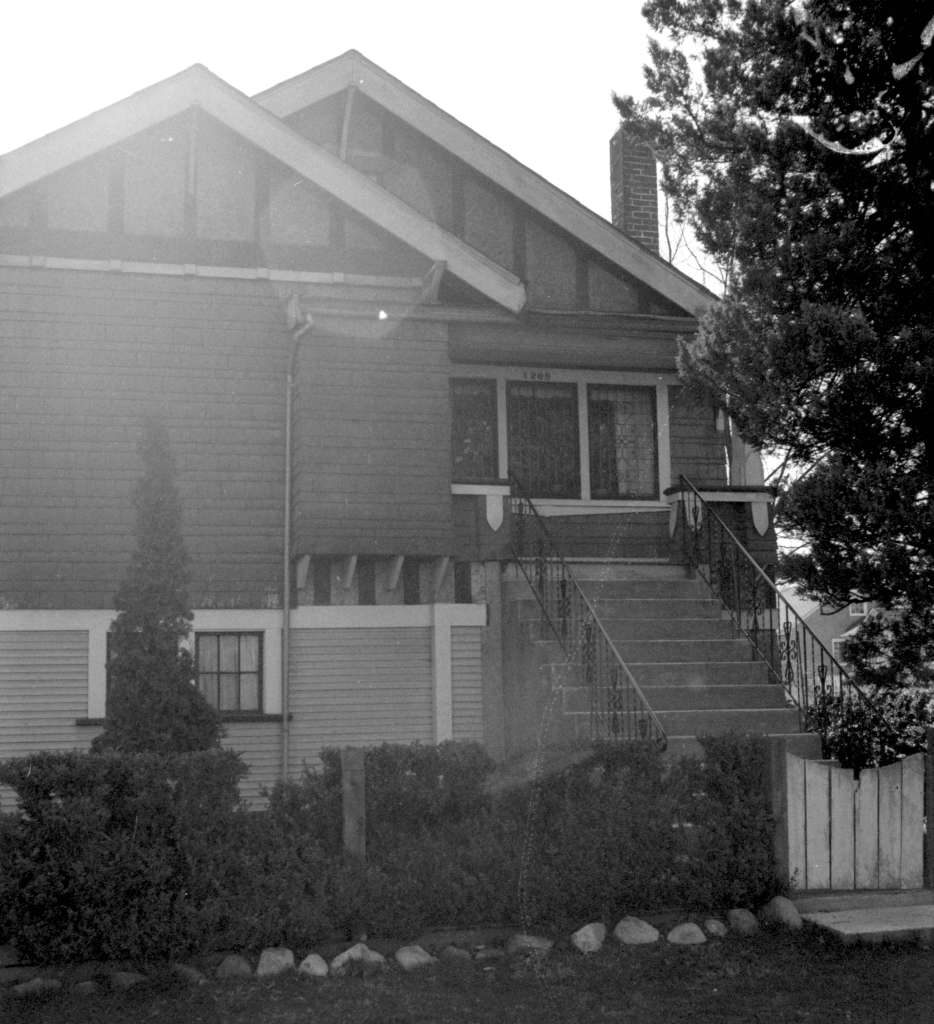I recently received a photo album filled with snapshots of houses in a variety of Vancouver neighbourhoods. As I was flipping through the pages a post card fell on to my desk.
It’s a blue tinted card showing the Eiffel Tower as viewed from the Trocadero. Nothing special, except on the back of the card the handwritten note says that the card was found in a house in November 1996 just before its demolition. The house at 1208 East 31st Avenue in Vancouver was the home of a Miss Eileen Neeves who had passed away in August at the age of 79. The post card mentioned her garden and that she was a piano teacher.
The house was built in 1922 at a cost of thousand dollars and would be the Neeves family home until Eileen’s death. Her parents Albert and Winifred Neeves were both born in England, Albert in Ticehurst, Sussex in 1885 and Winifred in Northampton in 1889. They both immigrated to Canada separately in 1907 and 1909.
According to a 1962 newspaper article about their Golden wedding anniversary the couple met while in service at Government House in Ottawa. They were married in Vancouver at Christ Church in 1912 and after the marriage the couple returned to England.
Why they got married in Vancouver is unclear, though they were working for the Governor General at this time and the household was out on the West Coast for a well received tour. Maybe they got hitched as they made plans to return to England. Who knows.
On their return to England the couple settled in the village of Arthur’s birth, Ticehurst, where their eldest daughter Nora was born in 1913. However, shortly after their arrival war broke out and Arthur signed up for the Canadian Expeditionary Force and served as a Lance Corporal in the 47th Battalion. At the war’s end with Albert off active service Eileen entered the world in 1919. The couple remained in England for another year before making the move back to Vancouver where they rented a house on East 26th. Avenue in South Vancouver.
Records show a building permit was taken out in early 1922 and interestingly, the name of the owner on the application is T. Neeves which could have been Albert’s father Thomas, though there is no record of him in Vancouver. On the subsequent permit in 1924 for the garage Winifred is listed as the owner and when the 1926 permit is taken out for the addition to the front of the house, Albert is listed as the owner and builder.
Albert, Winifred and daughters Nora, Eileen and Pauline moved into their new house at the end of 1922. Eileen and her sisters attended McBride Elementary and Eileen graduated from John Oliver high School in 1935.
Music was a big part of the Neeves social life. Albert on his return to Canada got a job with Begg Motors and is listed as an auto painter, but at the annual company banquets both Albert and Eileen were asked to perform. Eileen’s instrument was the violin and she played at a number of events including a big Victory Loan fundraiser during WW2.
By the late 1940s Eileen is advertising violin and guitar lessons in local papers and in the 1950s she shares studio space in the 21st. Avenue home of her sister Nora Davies where they offered lessons for violin, guitar, mandolin, and viola. Their partnership continued for many years and in 1968 adverts appear for The Music Studio where Nora Keats ( Nora was widowed in 1950 and had remarried a few years later) offered piano theory with Eileen offered violin theory. The studio would last until Nora’s death in 1975.
Eileen never marries and after the death of her father in 1969 she continued to live in the house with her mother who passed away at the age of 93 in 1981.
Lost pets seem to turn up regularly at the Neeves house starting with an Alsatian in 1939, a tortoise shell cat in 1959, a part Persian cat in 1962 and many kittens to be given away over the years.
The house that Albert Neeves built wasn’t spectacular or overly distinguished but it was a comfortable family home that encompassed an interesting family history. And thanks to the post card that was rescued before its demolition we could unravel the story.


